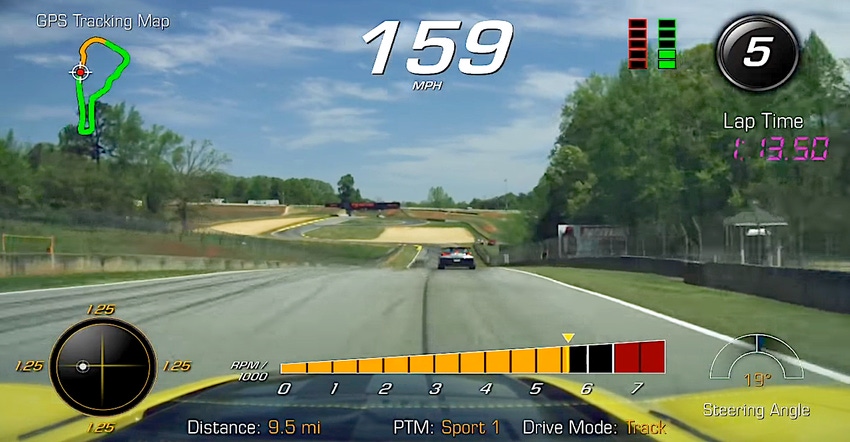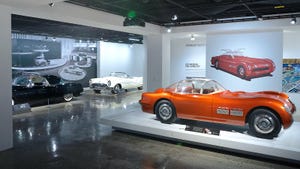The built-in video and data recorder has been a hallmark of Corvettes and hot-rod Cadillacs since 2015.

We live in an information age, and legendary British motorsports supplier Cosworth is the source of information for Chevrolet Corvette drivers thanks to the company’s Performance Data Recorder (PDR) system.
The Cosworth PRD comprises a video camera mounted behind the Corvette’s windshield and a computer that gathers relevant data from all the car’s sensors via its CAN bus to create a recording of the car’s travel with the data occurring at that time illustrated via a graphic overlay on the video.
The system, which is also available on other high-performance Chevrolet and Cadillac models, displays information such as vehicle speed, engine rpm, gear selection, throttle position, brake pressure, lateral and longitudinal acceleration, and GPS location data. The GPS operates at a faster refresh speed than the one in the car’s in-dash navigation system for a more precise location. In addition to providing this information on the video graphics, the raw data is also available to drivers for study in the Cosworth Toolbox Microsoft Windows software for closer review.
It is no surprise that such a system would come from a company with a long history in motorsport like Cosworth, because it is basically an easy-to-use version of the data acquisition systems employed by racing teams when they go to the track.
“The Performance Data Recorder combines the ability to record and share drive videos with the power of a professional-level motorsports telemetry system,” said Tadge Juechter, Corvette chief engineer. “Drivers can easily record and share their experiences driving down the Tail of the Dragon or lapping Road Atlanta. In addition, with the included telemetry software, users can analyze their laps in incredible detail and find opportunities to improve their driving and lap times.”
The Cosworth Toolbox application overlays recorded laps on a Bing-enabled satellite map of the track and compares selected laps in detail for any requested point on the drive. Comparisons include corner traces, vehicle speed, and cornering force to help drivers improve their driving consistency and ultimately their lap times.
“The ability to review laps between track sessions can identify immediate adjustments for quicker laps in the next session,” said Juechter. “It’s like having a 32-GB crew chief trackside providing you with real-time feedback to improve your driving skills.”
Cosworth already worked with the Corvette racing team, providing data acquisition and analysis systems, so it was a natural partner for the company’s production system. GM’s research showed customers were adding aftermarket data loggers to their cars to record performance, which made the idea of a factory-installed system an obvious benefit for those customers.
That factory installed brings with it the expectation of near-perfection, which presented a challenge for Cosworth as it was integrating what is effectively an aftermarket product. “Even though I have worked in the Automotive industry for entire end-to-end vehicle validation, dealing with PDR ECUs can be challenging as the ECU has many differences in hardware and software,” explained Cosworth validation engineer Swati Soni.
“As suppliers, we get specifications from GM on how they want the PDR function to work,” she continued. “These requirements must be captured, broken down into test cases, and then developed into real-time test scenarios. This is a part of the PDR system’s end-to-end validation process. As we try to simulate real-world scenarios on our test benches, we validate any requirements using real-time hardware. If we receive defects from the OEM, we attempt to reproduce the issues on our test benches using Simulation Tools in order to fully understand the issue. When we are able to accurately replicate the bug, we investigate why it occurred and attempt to find a solution.”
The importance of the supplier to the final product was impressed on Soni during her time working for automotive OEMs such as Nissan. “Previously, I was usually working with OEMs, where I learned a variety of end-to-end vehicle development processes,” she said. “I’ve worked with suppliers before, and I’ve realized how vital and difficult supplier tasks are.”
“I was astounded by how in-depth a supplier’s understanding of the issue was,” Soni continued. I was really interested in learning how they handled all of their development systems, as I was always doing end-to-end testing. Working at Cosworth, on the other hand, allows you to learn the finer points of each and every piece, which is something that especially fascinates me.”
The PDR system records video with these real-time data overlay options:
Track Mode – shows the maximum level of data on the screen, including speed, rpm, g-force, a location-based map, lap time, and more.
Sport Mode – shows fewer details on the overlay but includes key data including speed and g-force
Touring Mode – simply records and displays video and audio of the drive with no data overlay
Performance Mode – records performance metrics, such as 0 to 60 mph acceleration, 1/4-mile speed and elapsed time, and 0-100-0 mph runs.
Switching the car’s display to show the PDR’s video and data rather than the usual infotainment interface was a technical challenge for Cosworth. According to a post on that company’s blog, the handoff between the car’s ECU and the PDR’s ECU handling the display was tricky:
The way PDR works in current GM cars (the first and second PDR generations), is different from most infotainment apps as our ECU takes control of the infotainment screen and handles all graphics and user inputs. So, we had to make this monitor switch look as seamless as if it was just another app available to the driver.
Through our solution, we managed to control the monitor switching seamlessly using the CAN bus for all the touch processes that affect the PDR. Monitor switching is all about timing; the infotainment system informs the PDR to say that it is switching screens and sends a message over the first-generation LIN bus and the second-generation CAN bus. The relayed message informs the system to switch screens and take control, meaning that the PDR will also be taking control of any touch presses that come through.
At this point, PDR is responsible for handling what’s coming through. When the user wants to leave the PDR displays, the PDR must communicate back to the infotainment system to say that it is time to hand back control. For example, there are temporary times when the infotainment would need to take control, for instance, a navigation prompt or an incoming phone call. The main infotainment system will take the screen back temporarily and then pass control back to PDR.
In complex situations like these, we needed to make sure that no errors would occur during the changeover of control, so the user didn’t end up with a black screen because none of the systems were displaying anything.
Drivers piloting their cars around racetracks don’t need any kind of distracting issue from the display, so they surely appreciate this diligence by Cosworth in the execution of the PDR’s display function.
Special Corvette Content |
About the Author(s)
You May Also Like





